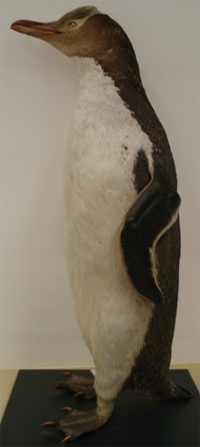Studying world’s rarest penguin leads to the discovery of a new species
Jeremy Hance, mongabay.com
November 19, 2008
|
|
Researching one of the world’s most endangered penguins in New Zealand, the yellow-eyed penguin, has led to a remarkable discovery. DNA from 500-year-old penguin fossils has shown that the country was once home to not just one penguin species, but two. The DNA has resurrected an unknown extinct penguin, which researchers have named the Waitaha Penguin.
The finding changes the biologists understanding of New Zealand’s past. It is believed that the Waitaha Penguin was the original inhabitant of New Zealand, while the yellow-eyed penguin was a later interloper. Around 1500 AD the Waitaha Penguin went extinct, allowing the yellow-eyed penguin to advance its range to New Zealand.
 Canterbury Museum, A mounted specimen of the yellow-eyed penguin |
“Our findings demonstrate that yellow-eyed penguins on mainland New Zealand are not a declining remnant of a previous abundant population, but came from the sub-Antarctic relatively recently and replaced the extinct Waitaha Penguin,” said team member Dr Jeremy Austin, deputy director of the Australasian Centre for Ancient DNA.
“Previous analysis of fossil records and anecdotal evidence suggested that the yellow-eyed penguin was more abundant and widespread in the past, but it now appears they have only been around for 500 years,” he said.
While scientists do not know for certain what caused the extinction of the Waitaha Penguin, they believe it was probably due to hunting by humans. Although widely debated, Polynesians are thought to have settled in New Zealand in large numbers by the fourteenth century. The Waitaha Penguins were probably easy to catch and it is thought that it only took a hundred or so years before the species was on the brink of extinction.
The Waitaha Penguin joins a long list of New Zealand species that went extinct due to the settlement of the islands by humans. Ten species of moas, twelve-foot tall and flightless, faced extinction at the same time as the Waitaha Penguin, most likely due to hunting by the Polynesians as well. The extinction of the moas led to the demise of the Haast’s Eagle, the world’s largest eagle, which preyed on the moas.
The yellow-eyed penguin is classified as endangered by the IUCN red list with 7,000 left.